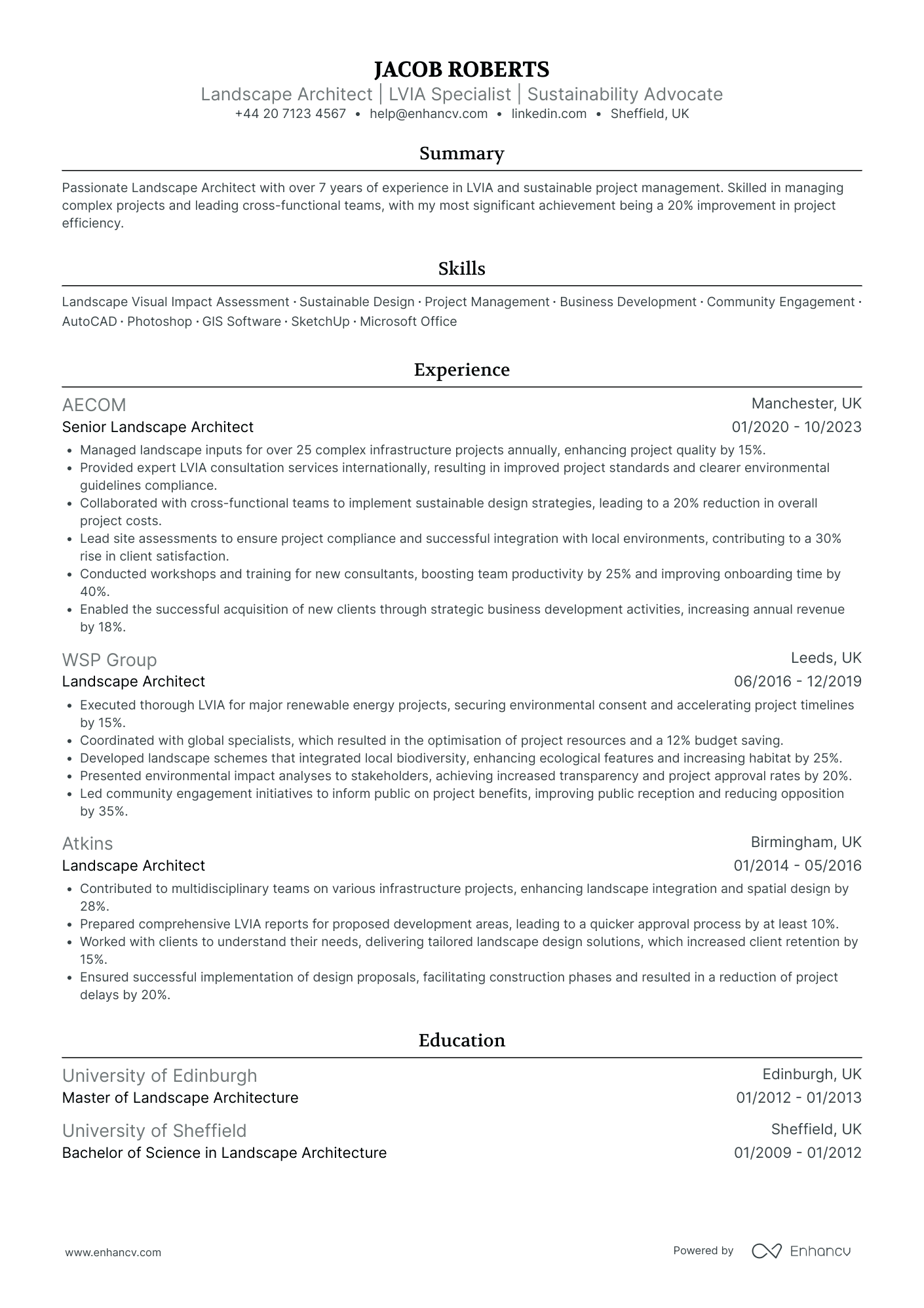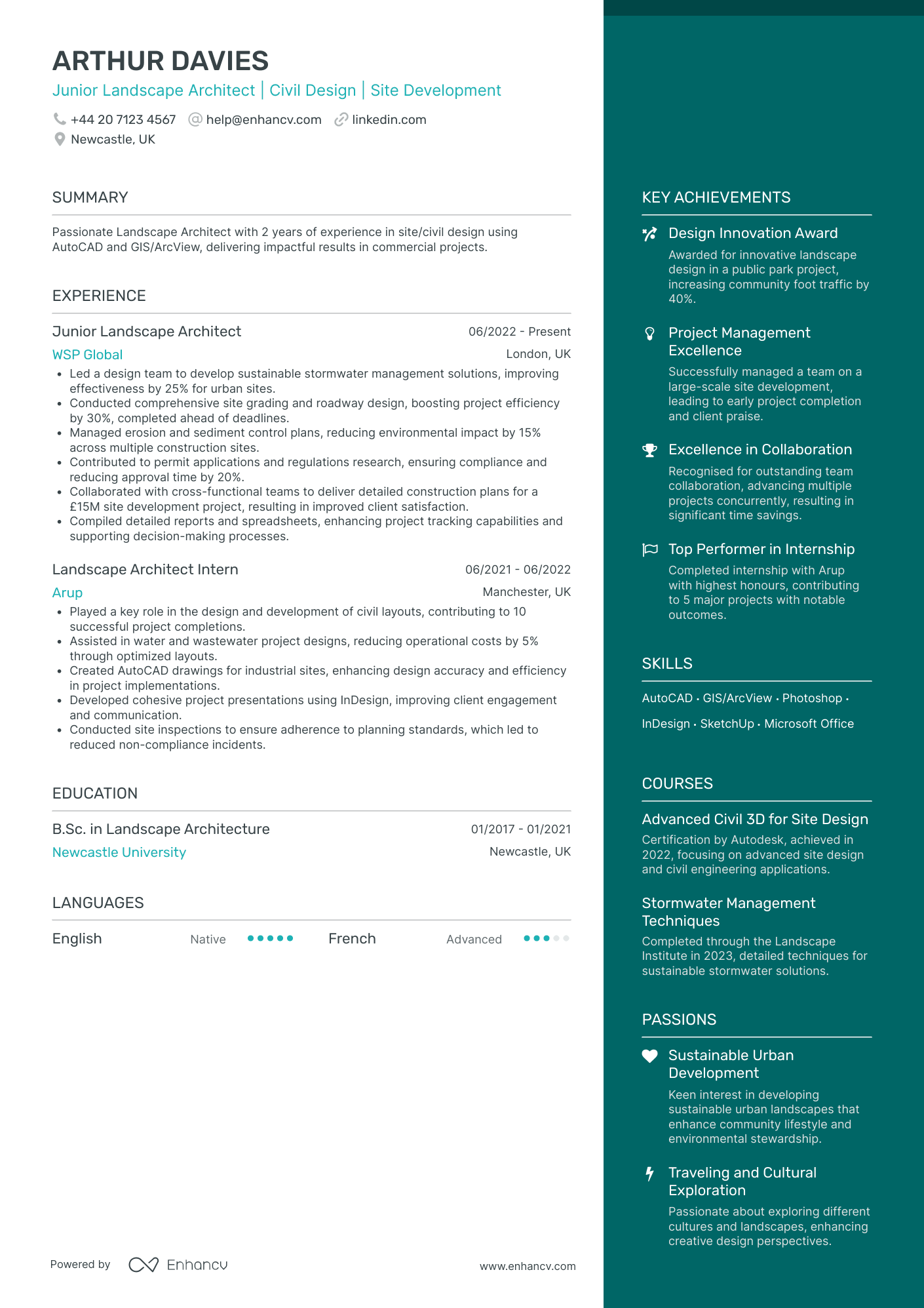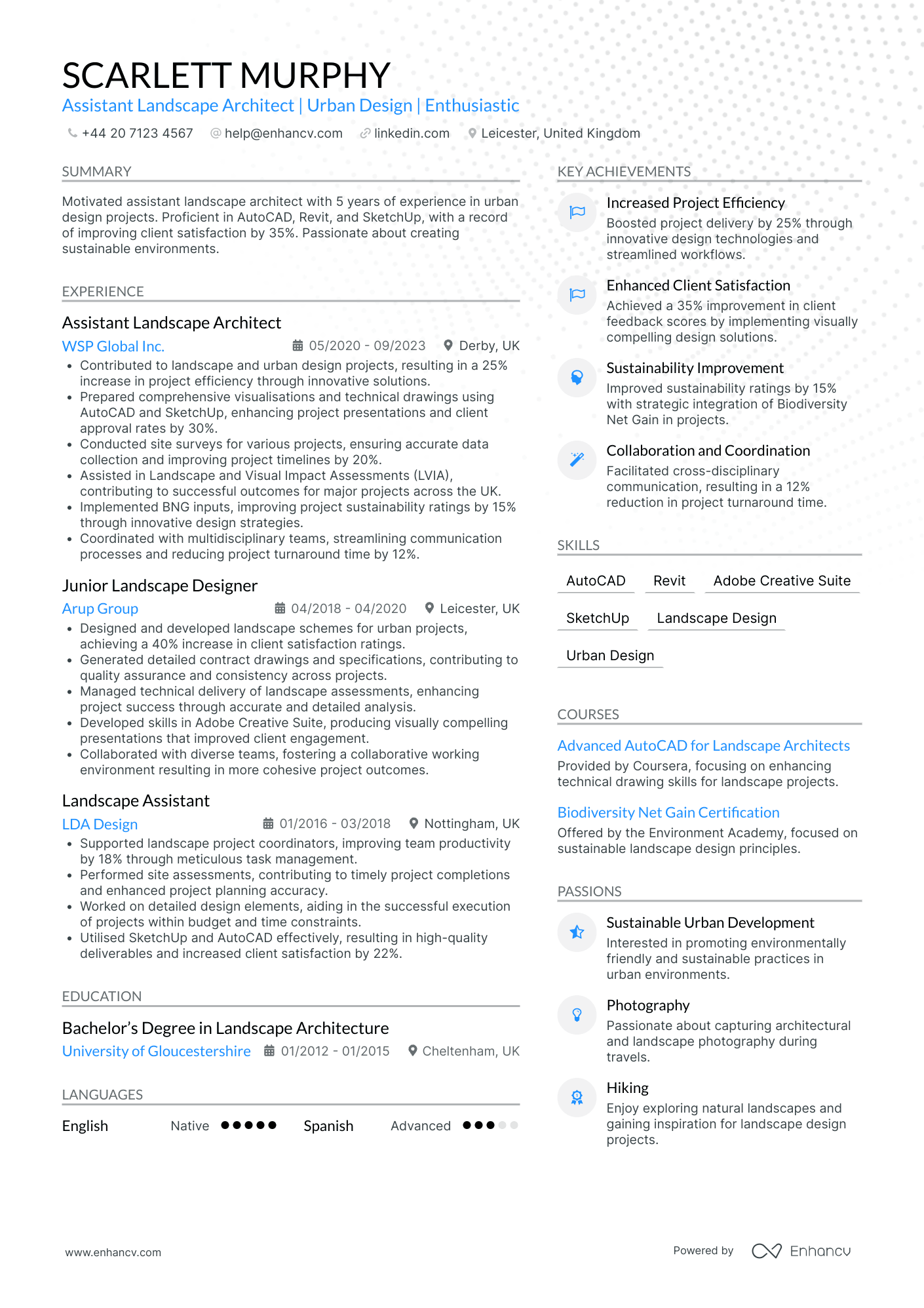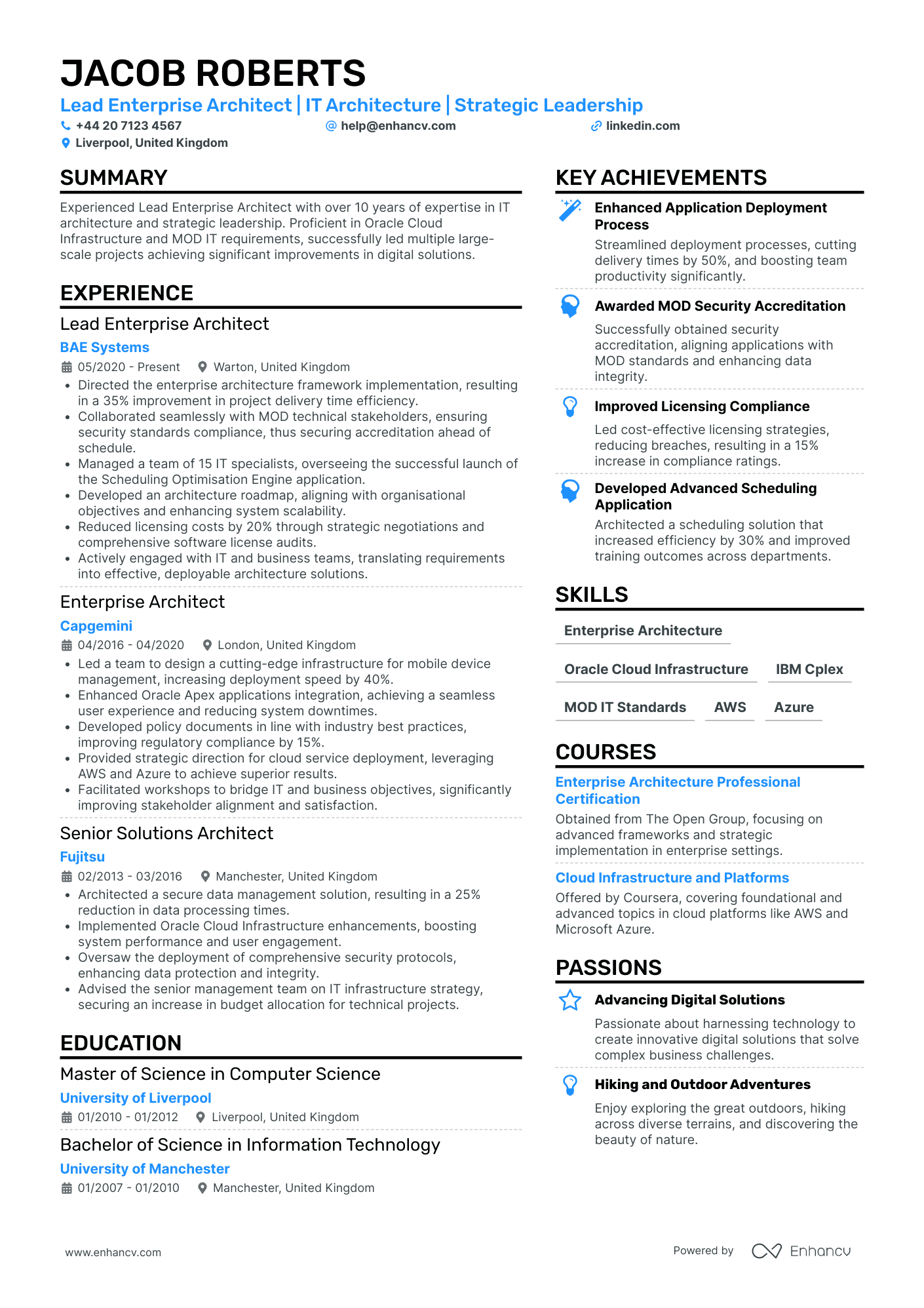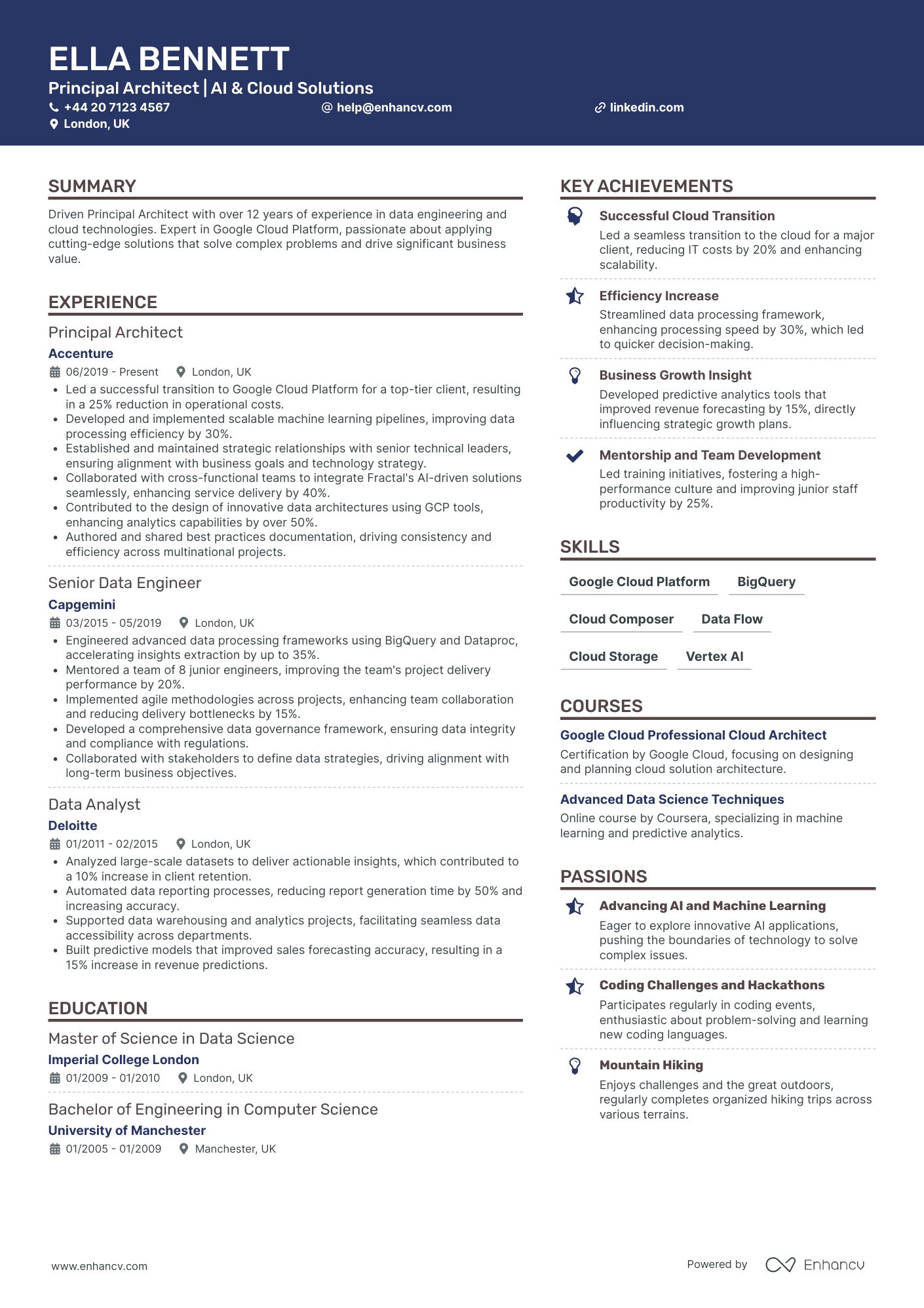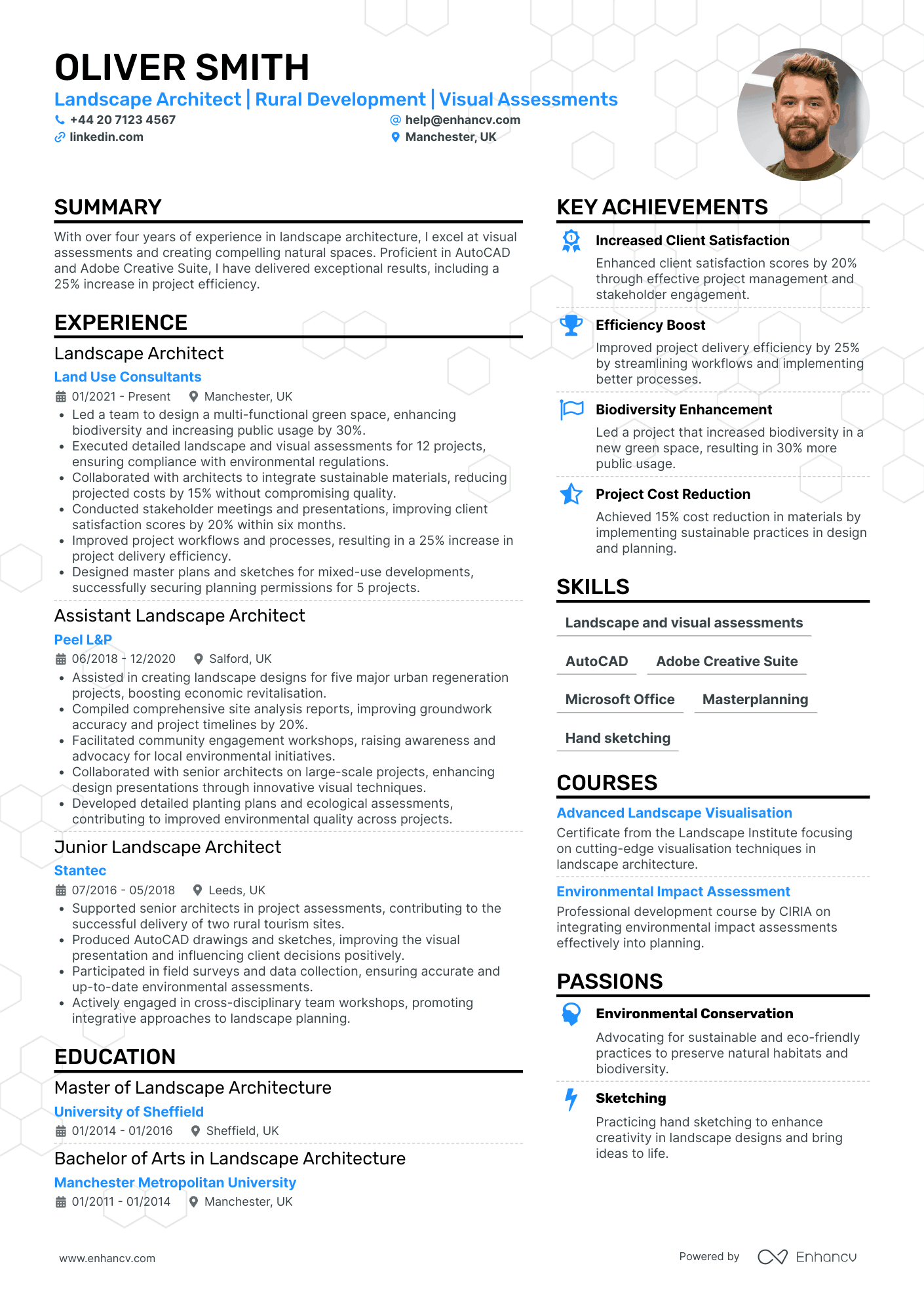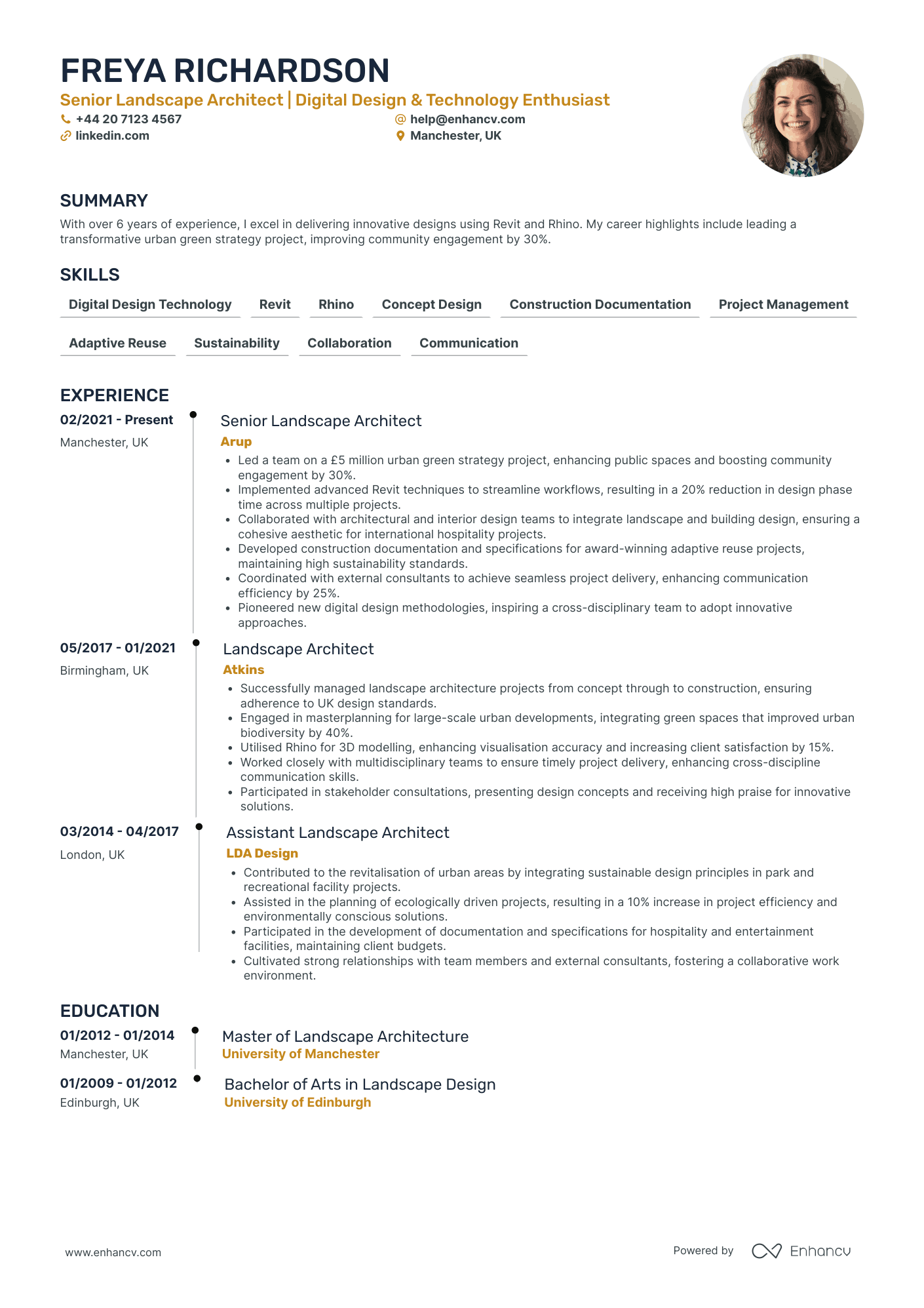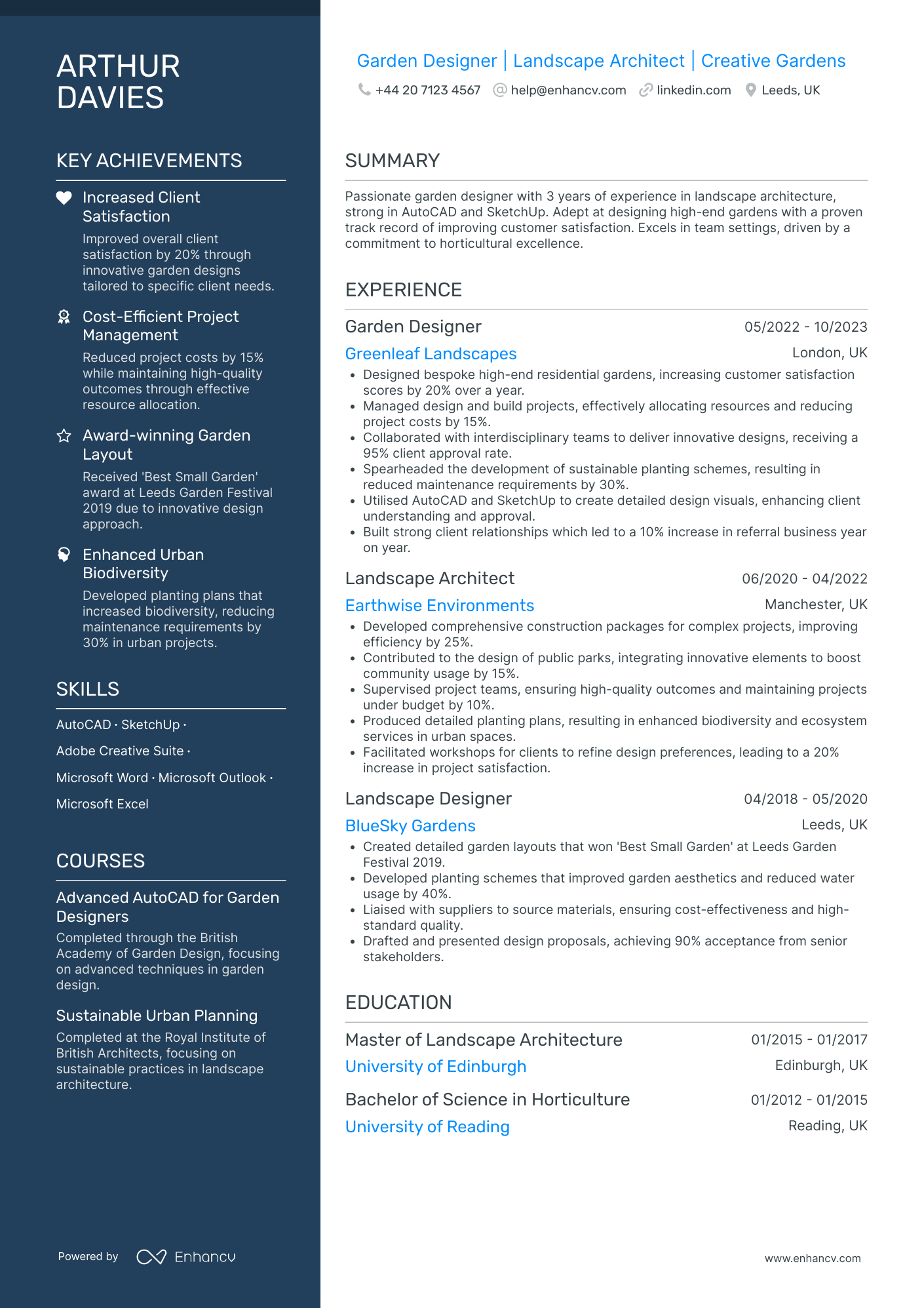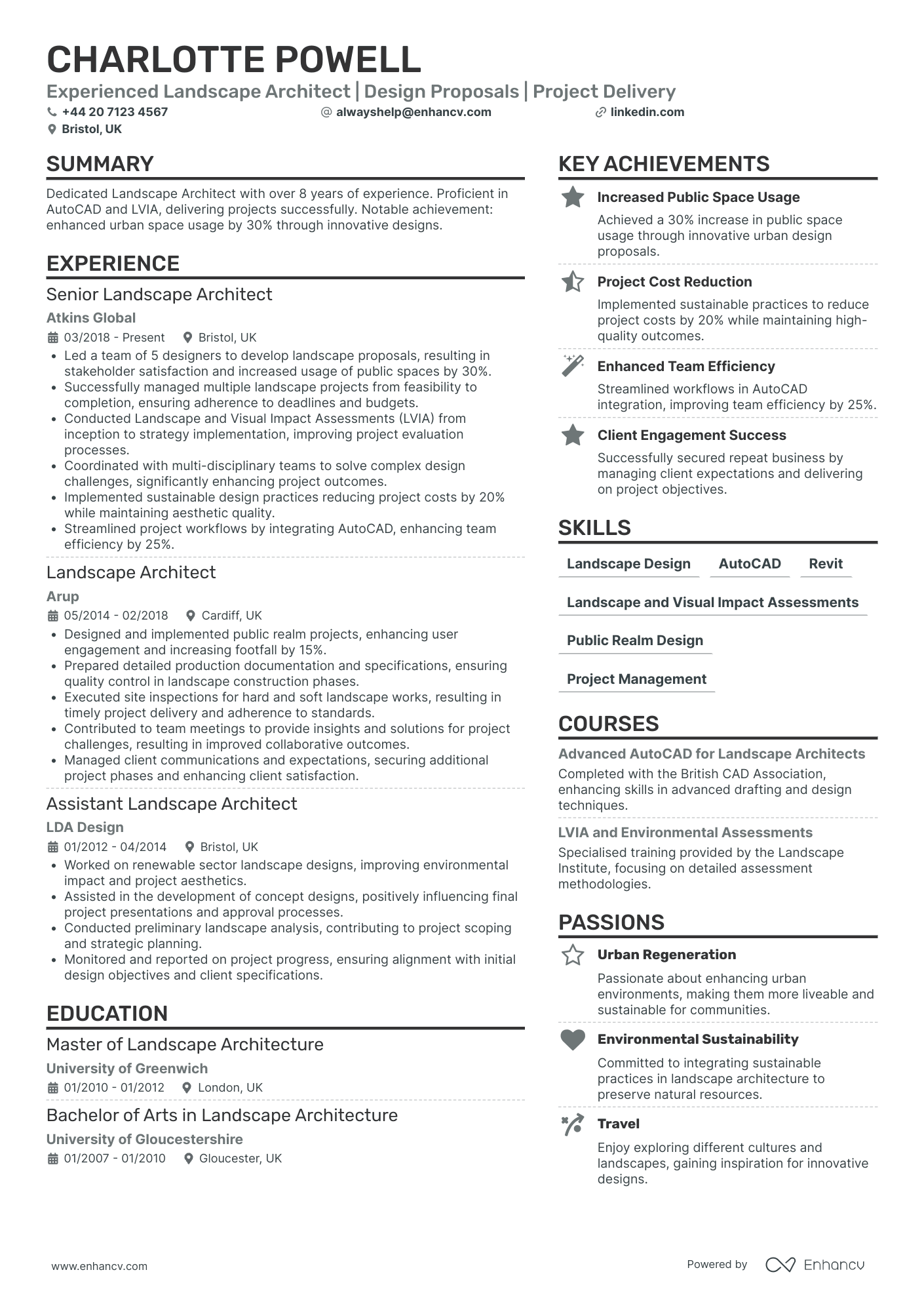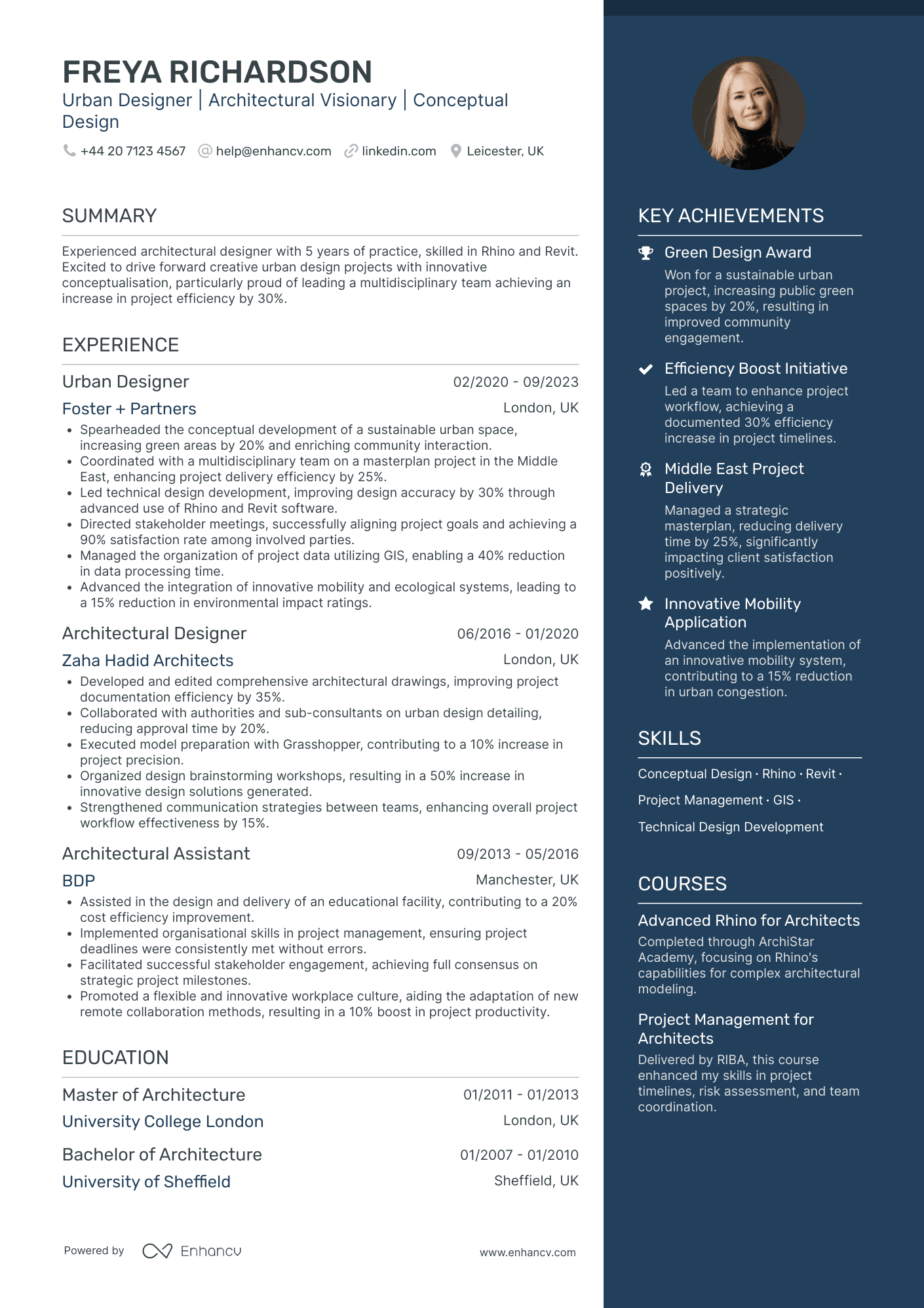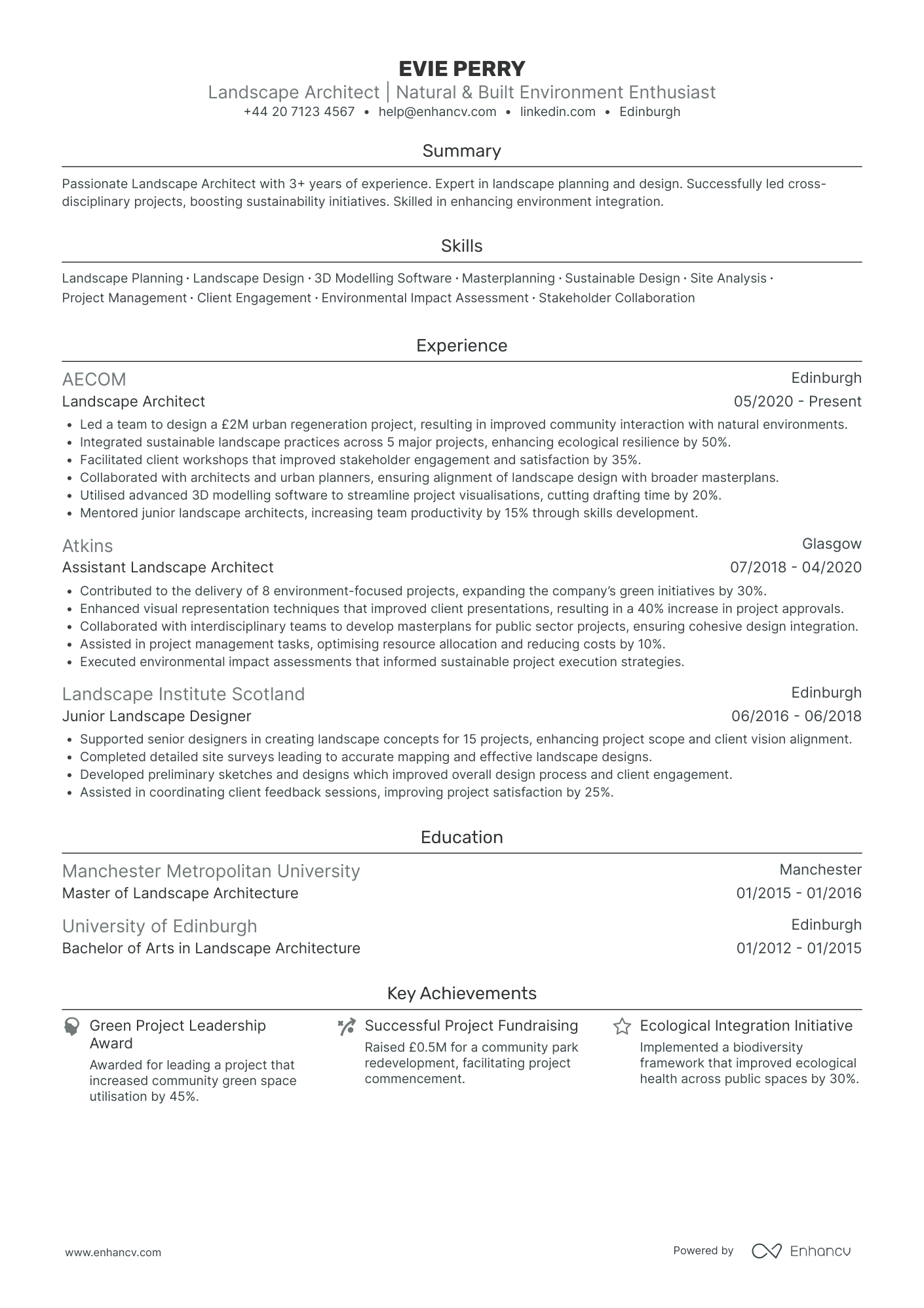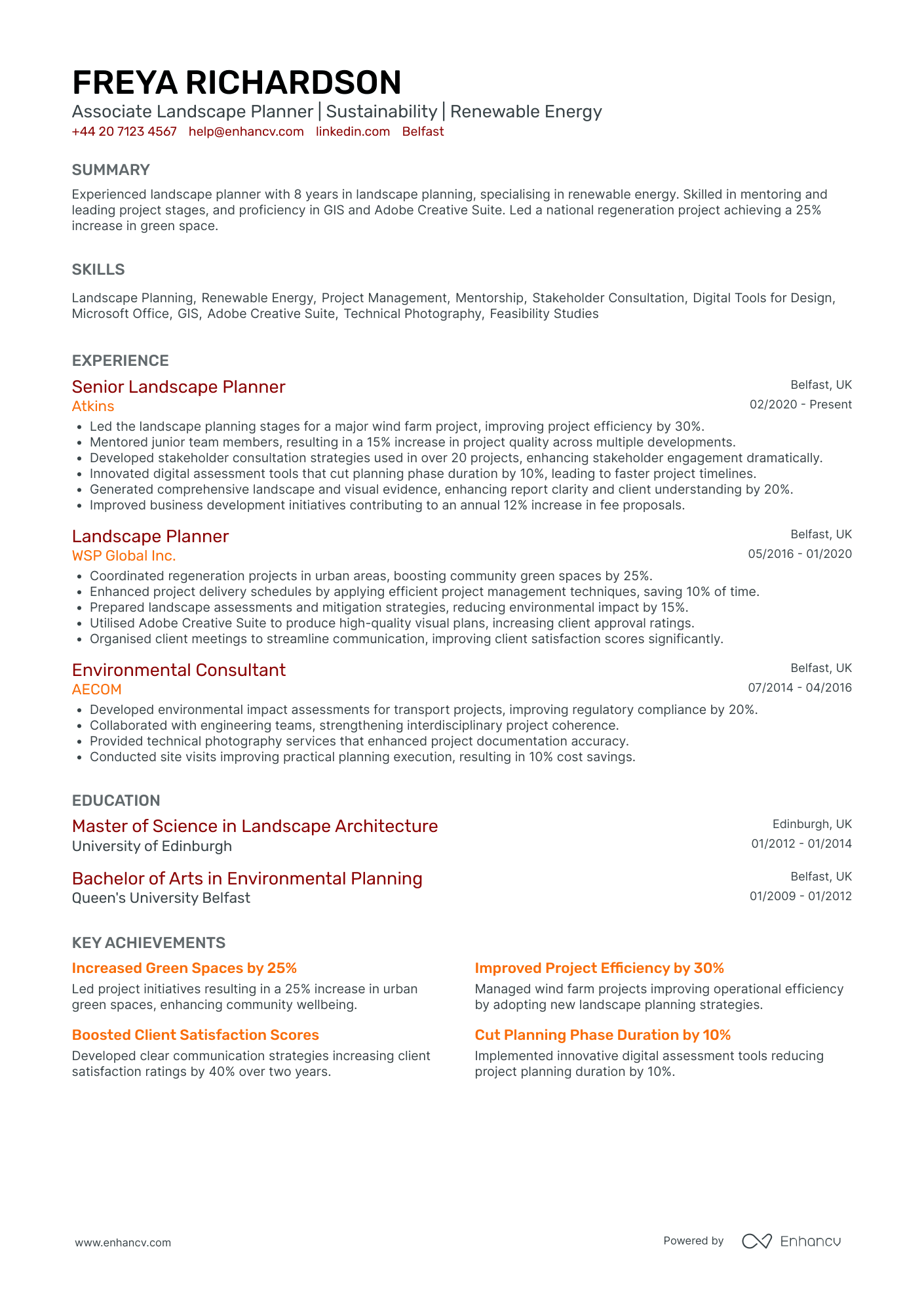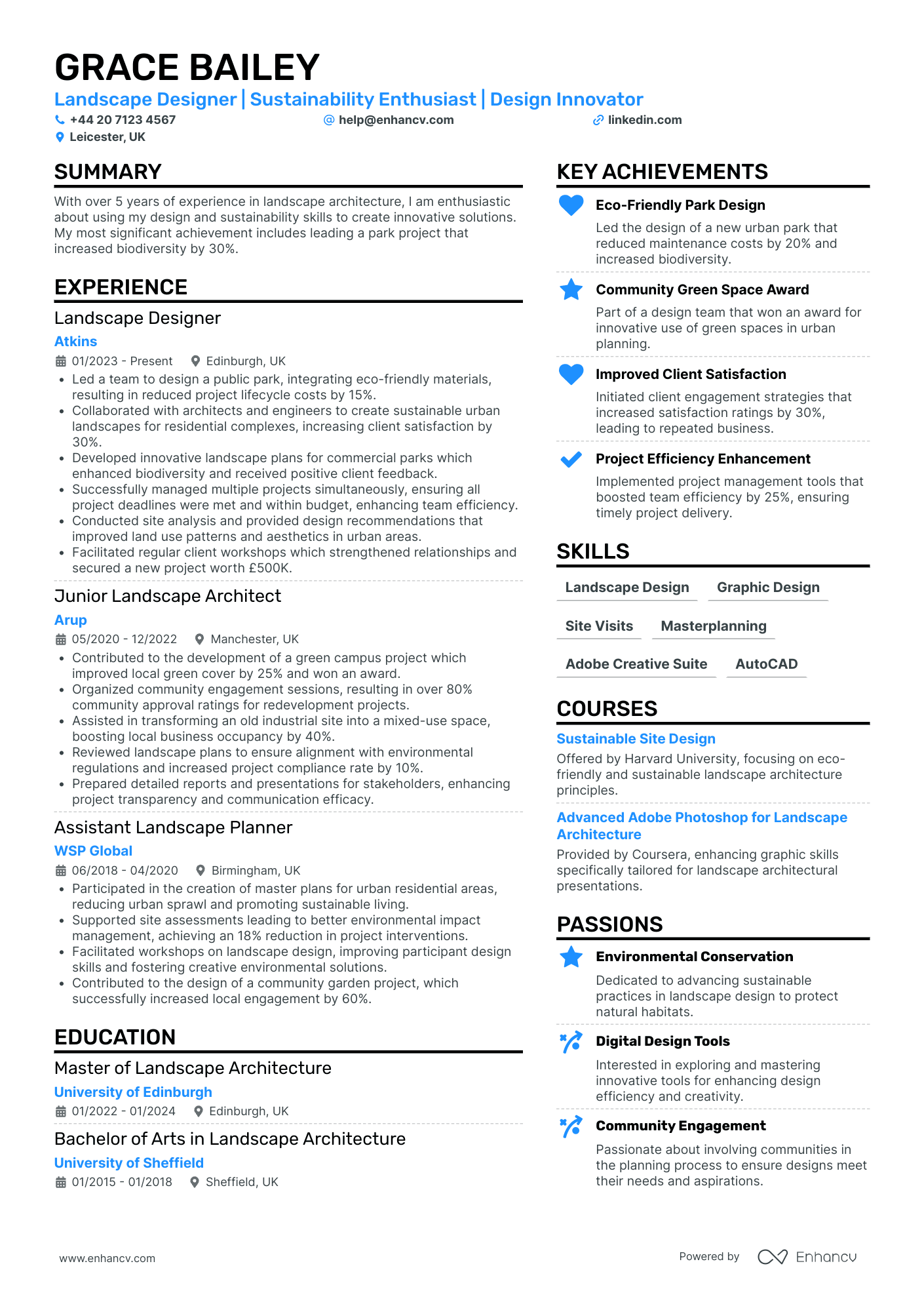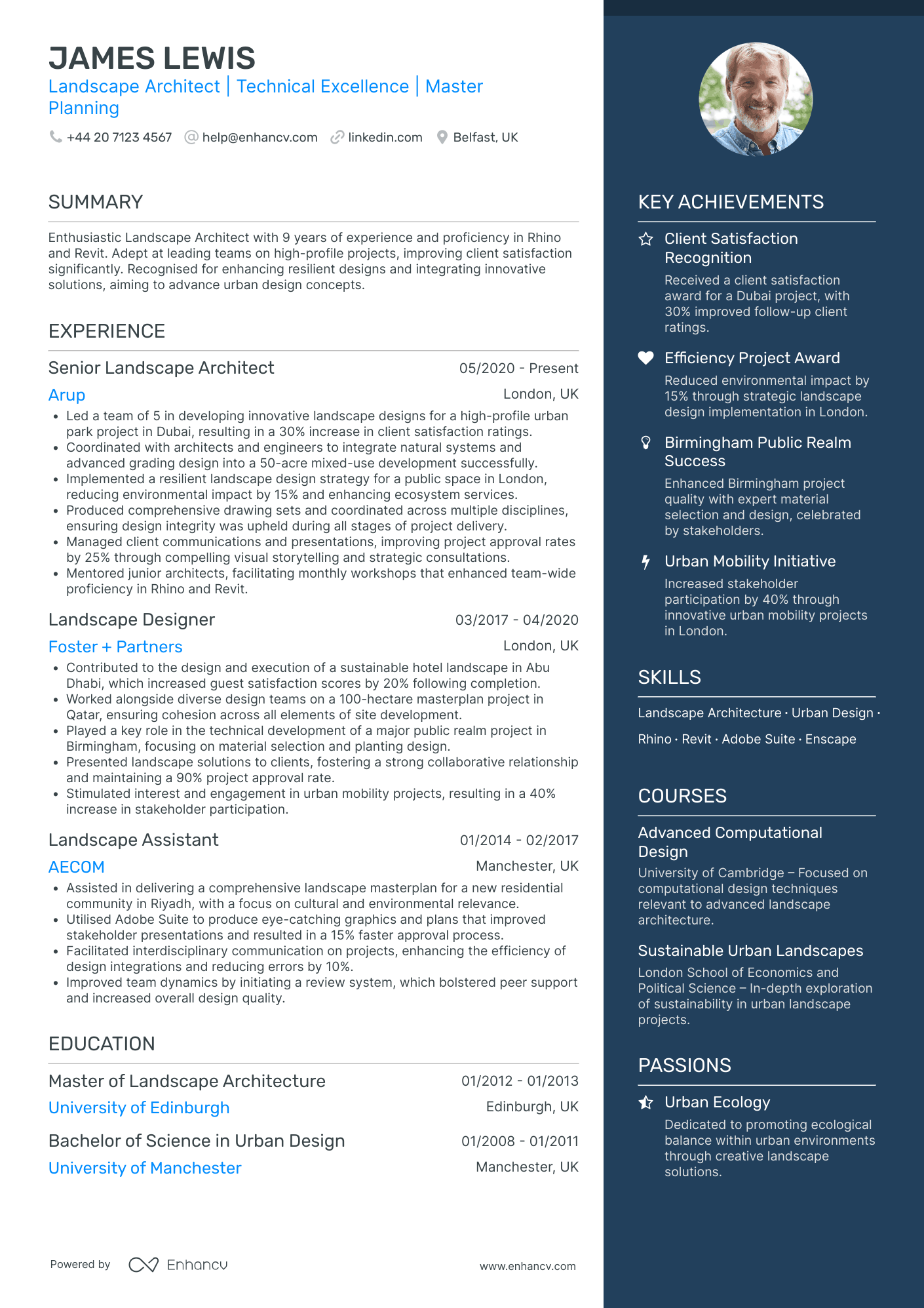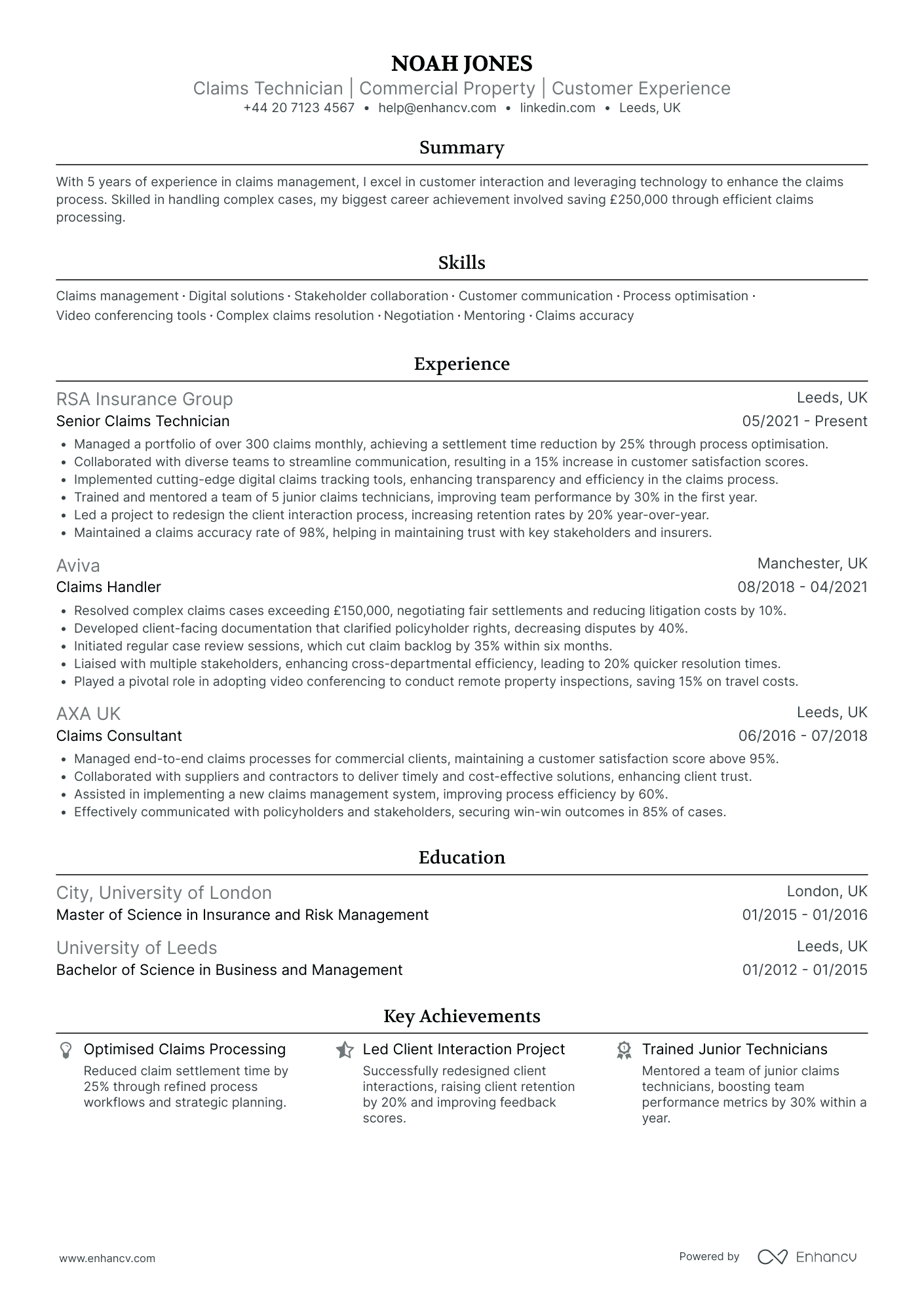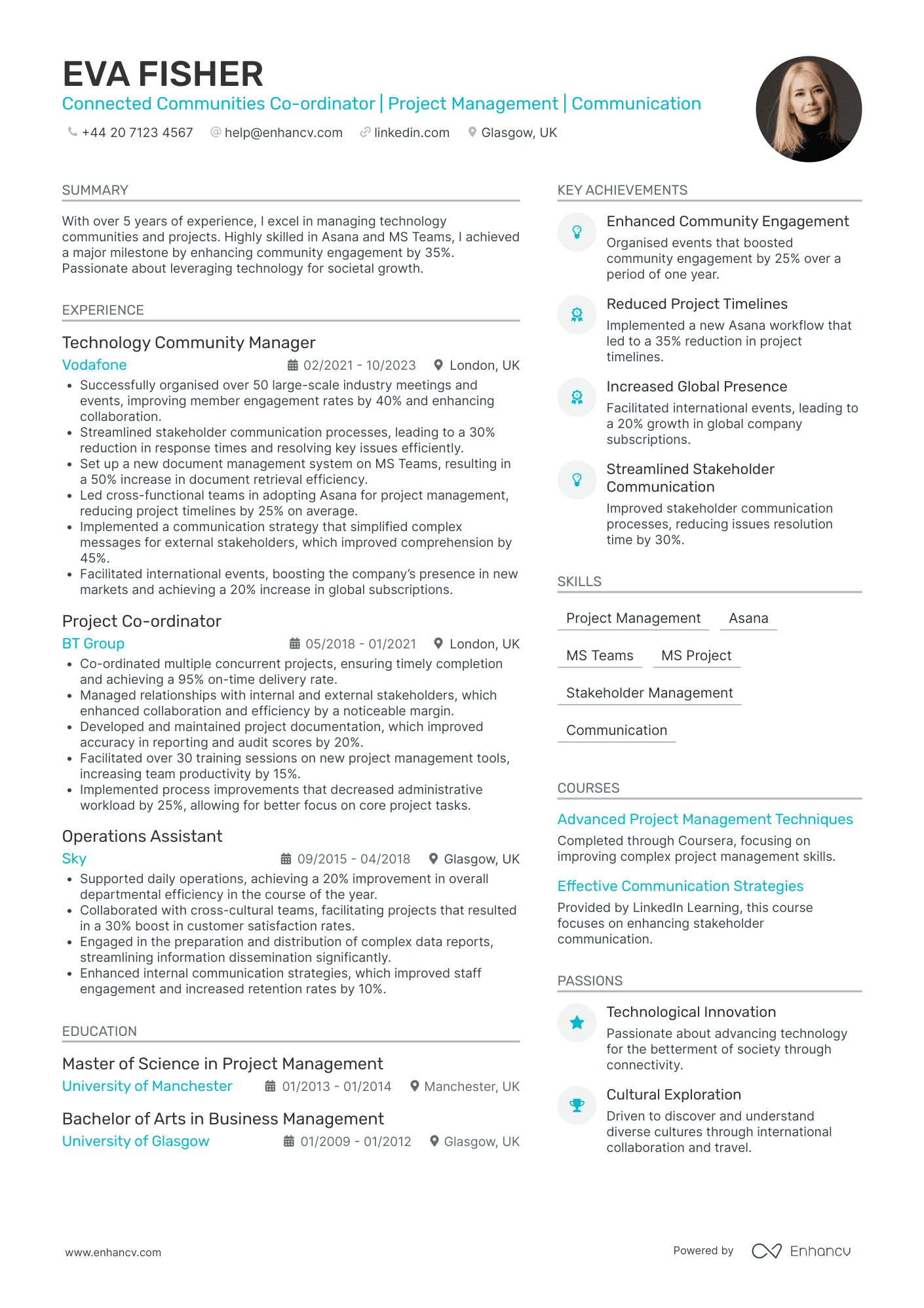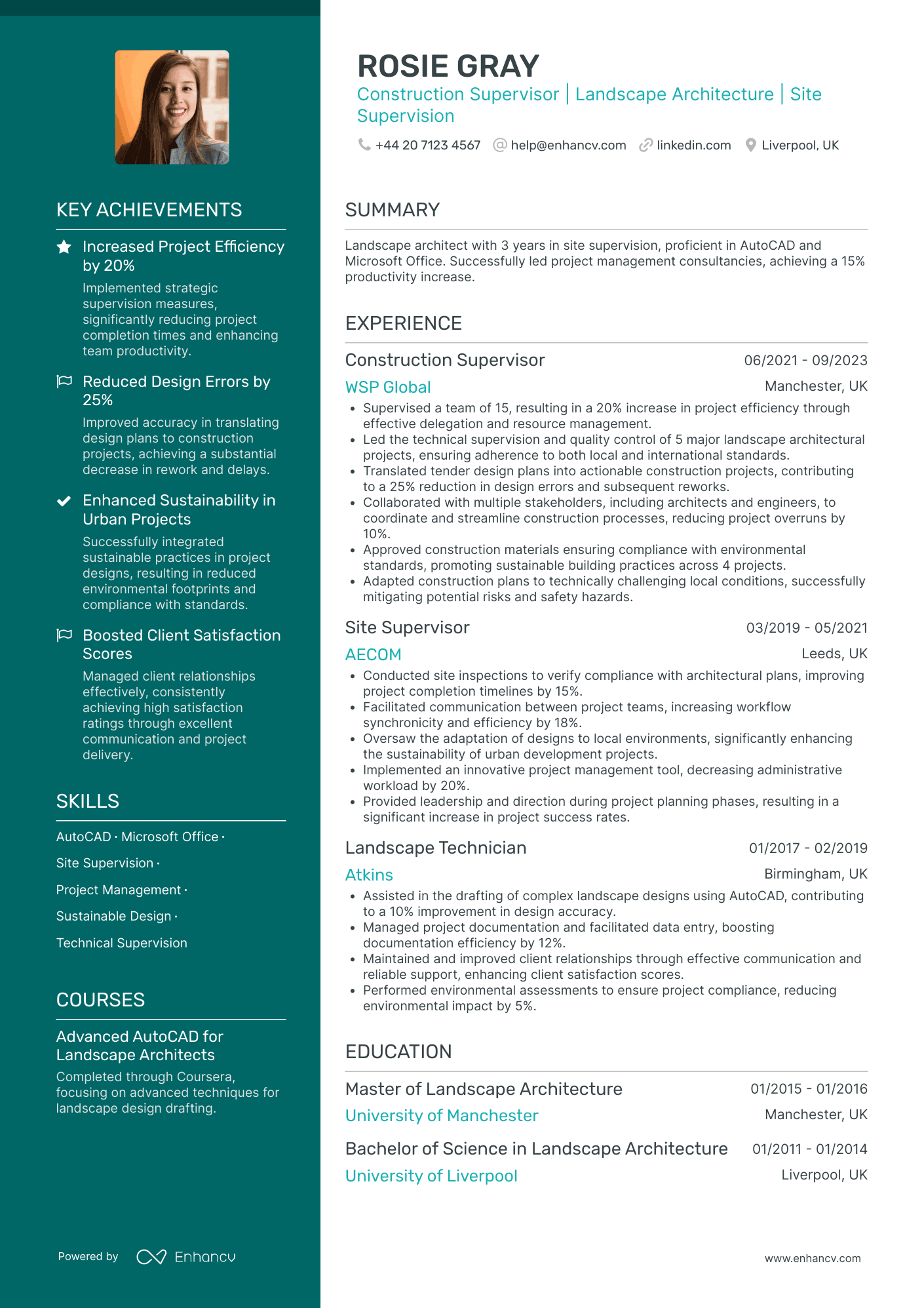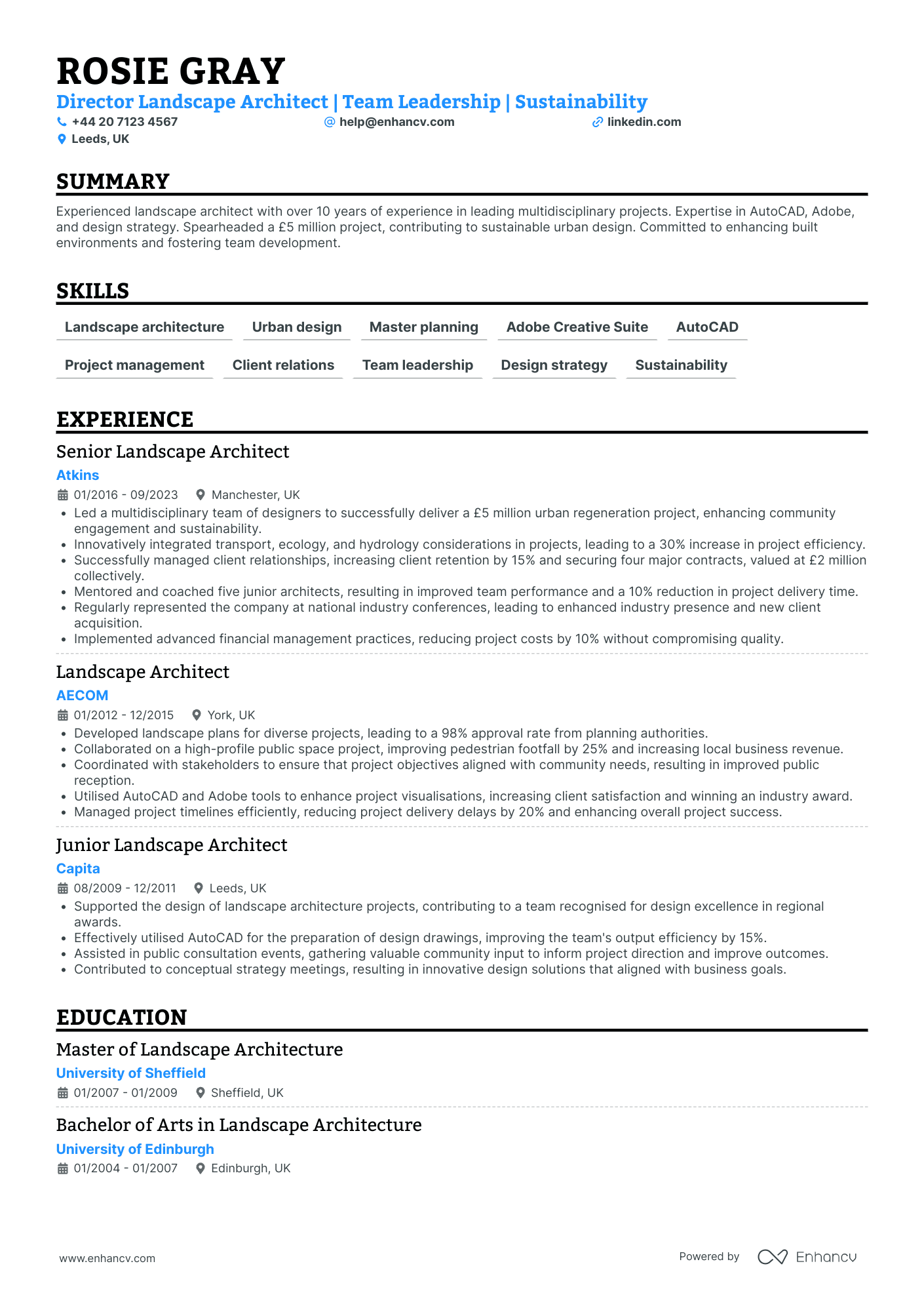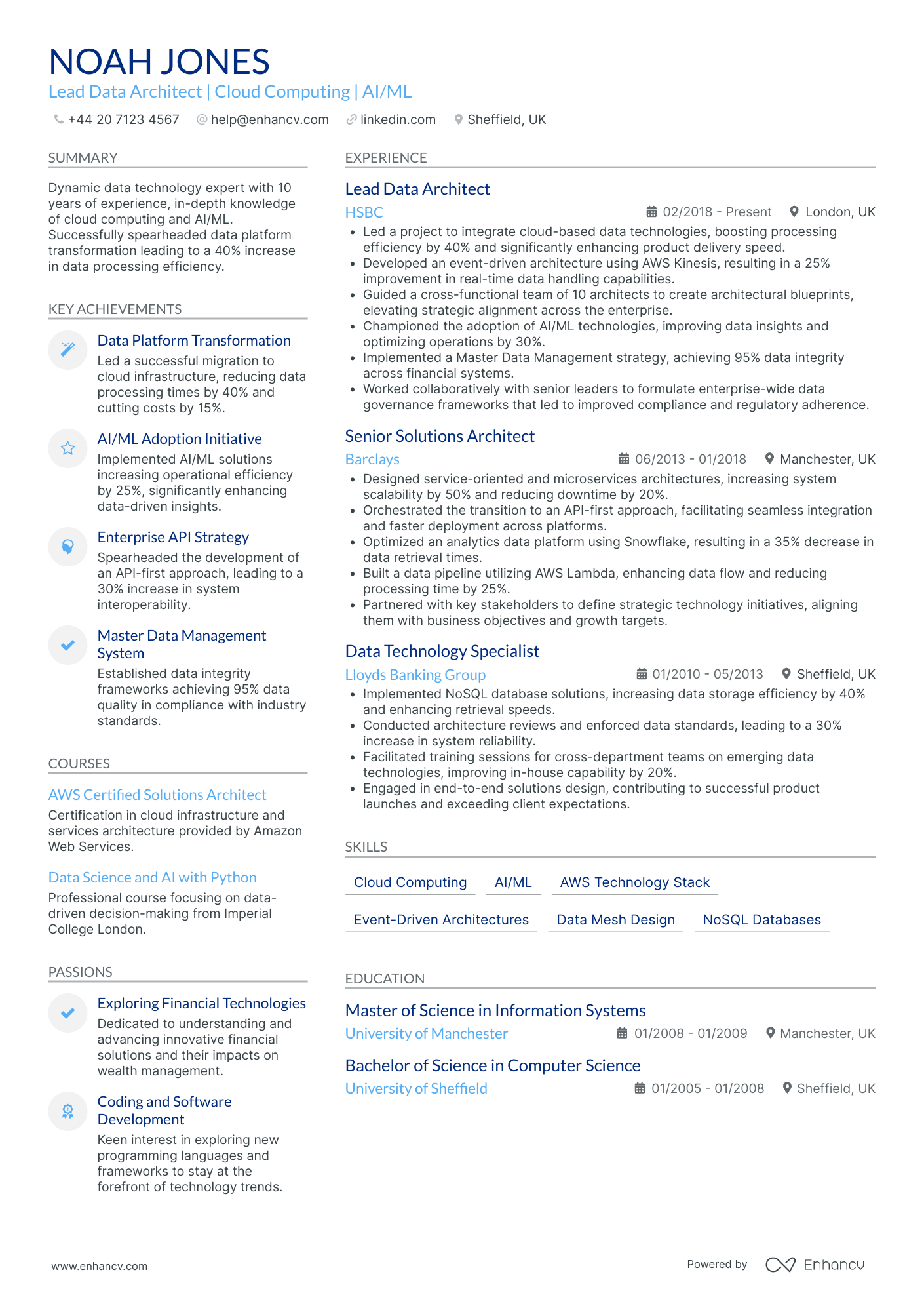One of the CV challenges you may encounter as a landscape architect is effectively highlighting technical expertise alongside creative project experience. Our guide offers tailored strategies to strike the right balance, ensuring your unique blend of skills shines through to potential employers.
- Design and format your professional landscape architect CV;
- Curate your key contact information, skills, and achievements throughout your CV sections;
- Ensure your profile stays competitive by studying other industry-leading landscape architect CVs;
- Create a great CV even if you happen to have less professional experience, or switching fields.
When writing your landscape architect CV, you may need plenty of insights from hiring managers. We have prepared industry-leading advice in the form of our relevant CV guides.
Resume examples for landscape architect
By Experience
Senior Landscape Architect
- Comprehensive Project Management Skills - Jacob Roberts' CV showcases his exceptional project management capabilities, particularly through detailed descriptions of his roles in leading complex infrastructure projects. By managing landscape inputs for over 25 projects annually, he has demonstrated his ability to enhance project quality and efficiency significantly.
- Strong Career Progression - The CV reflects a solid ascent in Jacob's career from a Landscape Architect at Atkins to a Senior Landscape Architect at AECOM. This trajectory indicates his evolving expertise and growing leadership responsibilities, emphasizing his dedication and skill in the field.
- Integration of Sustainability in Design - Jacob’s expertise in sustainability is evident throughout the CV, particularly in how he implements sustainable design strategies that lead to a 20% reduction in project costs. This focus on environmentally conscious practices aligns with industry trends and showcases his commitment to sustainable architecture.
Junior Landscape Architect
- Effective Content Presentation - The CV presents information in a clear and structured manner, making it easy to follow and understand. The use of concise bullet points and organized sections ensures that key information, such as experience and skills, is readily accessible to the reader.
- Career Trajectory and Growth - Arthur has demonstrated a steady progression from a Landscape Architect Intern to a Junior Landscape Architect. This career trajectory highlights his growing expertise and increased responsibilities over time, underscoring his commitment to advancing in the field of landscape architecture.
- Industry-Specific Tools and Methodologies - Arthur's CV showcases his proficiency with industry-specific tools like AutoCAD, GIS/ArcView, and InDesign. These technical skills are critical for landscape architecture and civil design, highlighting his capability to effectively contribute to complex projects.
Assistant Landscape Architect
- Cohesive Structure and Information Flow - The CV boasts a clear and structured layout, seamlessly guiding the reader through Scarlett Murphy's qualifications and experiences. Each section is concisely presented, providing essential details without overwhelming the reader, which enhances readability and demonstrates her organizational skills.
- Progressive Career Development - Scarlett's career trajectory is indicative of continual professional growth within the landscape architecture industry. Starting as a Landscape Assistant and advancing to an Assistant Landscape Architect at reputable firms, her promotions and increased responsibilities reflect her dedication and proficiency in her field.
- Proficiency in Industry-Specific Tools - The CV highlights Scarlett’s mastery of specialized tools such as AutoCAD, Revit, and SketchUp, which are crucial in landscape architecture. Her ability to leverage these tools effectively has led to significant improvements in project presentations and client satisfaction, marking her as a standout professional in urban design.
Trainee Landscape Architect
- Structured and Concise Presentation - The CV is neatly organized, leading with a strong summary that encapsulates the candidate's vast experience in IT architecture and strategic leadership. Each section is clear with bullet points that highlight major projects and their outcomes, promoting a reader-friendly experience.
- Consistent Career Growth - Jacob Roberts' career trajectory showcases steady growth with progressive responsibilities. Starting as a Senior Solutions Architect and advancing to a Lead Enterprise Architect, his roles suggest a deepening of expertise and an ability to take on greater challenges and leadership positions in the IT sector.
- Effective Use of Advanced Technology - The CV highlights Roberts' expertise in enterprise-specific tools and methodologies like Oracle Cloud Infrastructure, IBM Cplex, and MOD IT standards. His ability to leverage these technologies to implement scalable solutions signifies a strong technical acumen applicable in complex and secure environments.
Principal Landscape Architect
- Clear and Concise Content Presentation - Ella Bennett's CV is structured with clarity, featuring distinct sections such as experience, education, skills, and achievements. The language is concise, with bullet points effectively summarizing key roles, responsibilities, and results, ensuring easy readability for potential employers.
- Career Trajectory and Growth - The CV illustrates a well-defined career progression from a Data Analyst at Deloitte to a Principal Architect at Accenture. This advancement demonstrates Ella’s ability to take on larger responsibilities and showcases her consistent upward movement in the technology sector over a period of 12 years.
- Expertise in Cutting-Edge Technology - Ella’s CV highlights her deep technical expertise with industry-specific tools and methodologies, including Google Cloud Platform, BigQuery, and Vertex AI. Her proficiency in these areas positions her as a leader who can innovate and implement complex cloud and AI solutions.
By Role
Landscape Architect Manager
- Clear and Structured Presentation - The CV excels in clarity and structure, starting with personal details and a concise summary, followed by well-organized sections for experiences, education, skills, and achievements. Each section flows logically, providing an easy-to-navigate layout that highlights Oliver Smith's qualifications and professional journey.
- Proven Career Growth - Oliver's career trajectory showcases a consistent progression from a Junior Landscape Architect to a leading role within his field. His experience spans reputable firms, illustrating continuous professional growth, deeper responsibilities, and increasing leadership roles that demonstrate his rising expertise in landscape architecture.
- Technical Proficiency and Methodologies - The CV stands out with its emphasis on specific industry tools and methodologies. Oliver's proficiency in AutoCAD and Adobe Creative Suite is noted, along with his mastery of landscape visual assessments, masterplanning, and sustainable practices, reflecting a comprehensive technical and industry-specific skill set.
Landscape Architect Consultant
- Structured And Concise Presentation - The CV effectively organizes information into clear sections, making it easy for the reader to quickly identify Freya's key qualifications. The bullet-point format for each job experience highlights relevant achievements and responsibilities concisely, ensuring important details stand out without overwhelming the reader.
- Diverse Technical Proficiency - Freya showcases a wide range of industry-specific tools and methodologies such as Revit and Rhino. This deep technical expertise not only highlights her proficiency in digital design and technology but also demonstrates her capability to leverage advanced tools for enhanced project outcomes in landscape architecture.
- Significant Achievements with Impact - The achievements section emphasizes meaningful, concrete results such as increasing community engagement by 30% and reducing design phase time by 20%. These metrics highlight Freya's ability to contribute positively to business outcomes, showcasing her as an impactful and results-oriented professional in her field.
Residential Landscape Architect
- Strategic career progression and focus - Arthur Davies' CV showcases a well-defined career path with roles that evolve strategically within the realm of garden and landscape design. His progression from a Landscape Designer to Garden Designer represents a targeted career direction, emphasizing growth from detailed design roles towards positions with greater strategic responsibility and leadership in managing both the design and build aspects of projects.
- Integration of sustainability into design - A standout feature of Arthur's experience is his commitment to sustainable garden practices, as reflected in the development of sustainable planting schemes and urban biodiversity projects. These efforts not only improve maintenance efficiency but also add significant value by enhancing the ecological impact of his designs, positioning him as a forward-thinking designer sensitive to the environmental needs of urban development.
- Interdisciplinary collaboration and client-centric approach - The CV highlights Arthur's ability to work effectively within interdisciplinary teams, contributing to innovative design solutions that enhance client satisfaction. His strong communication and relationship-building skills have consistently led to high client approval rates and increased referral business, demonstrating his adeptness at understanding and translating client needs into successful design outcomes.
Commercial Landscape Architect
- Structured and Clear Presentation - Charlotte Powell's CV is well-organized, with distinct sections for experience, education, skills, and achievements. Each section is concise, ensuring that key information is easily accessible. The clarity and structure make it simple for hiring managers to understand her qualifications at a glance.
- Comprehensive Career Progression - The CV illustrates a clear trajectory of growth, from starting as an Assistant Landscape Architect to her current role as a Senior Landscape Architect. This progression highlights her career advancement and increasing responsibilities within well-known companies like Atkins Global and Arup, reflecting her dedication and professional development in the field.
- Technical Expertise in Landscape Architecture - Charlotte's CV emphasizes her proficiency in industry-specific tools and methodologies, such as AutoCAD and Landscape and Visual Impact Assessments (LVIA). Her specialized courses further highlight her commitment to technical excellence, demonstrating deep knowledge and skills essential for impactful landscape architecture projects.
Urban Landscape Architect
- Structured and Focused Content Presentation - Freya Richardson's CV is well-organized, ensuring clarity and conciseness across all sections. Each job role is laid out in detail, with bullet points that effectively convey her key achievements and responsibilities. This structured approach ensures that her skills and experiences are communicated clearly and can be quickly grasped by recruiters.
- Strong Career Trajectory with Clear Growth - The career path outlined in the CV demonstrates Freya's upward mobility, starting as an Architectural Assistant and progressing to roles in high-profile companies like Zaha Hadid Architects and Foster + Partners. This growth indicates a continuous advancement in responsibility and complexity of projects, culminating in her proficiency in leading substantial urban design initiatives.
- Industry-Specific Technical Proficiencies - Freya showcases a wide range of industry-specific tools and methodologies, such as advanced use of Rhino, Revit, and GIS. These proficiencies highlight her technical depth and ability to efficiently contribute to complex urban and architectural projects, which is essential for an Urban Designer.
Landscape Architect Project Leader
- Structured clarity in content presentation - The CV is well-structured and clearly laid out, providing easy navigation through each section. This clarity highlights Evie's qualifications, work history, and educational background, ensuring that key points are accessible and understandable at a glance.
- Impressive career progression - Evie’s career trajectory is marked by progressive responsibility, starting as a Junior Landscape Designer and advancing to a Landscape Architect. Each role builds upon the last, demonstrating a steady climb within the landscape architecture field, notable for growth and increased project leadership.
- Integration of modern tools and practices - The CV illustrates Evie's adept use of advanced methodologies, such as 3D modeling and sustainable landscape practices. These tools underscore her technical depth and commitment to integrating modern technology and sustainability into her projects.
Landscape Architect Planner
- Impressive Content Clarity and Structure - Freya Richardson's CV is well-organized and concise, effectively utilizing sections to clearly present her extensive experience and relevant skills. The structured layout ensures easy navigation, allowing potential employers to quickly assess her qualifications and achievements in the field of landscape planning.
- Robust Career Trajectory Exhibiting Growth - Freya's progression from Environmental Consultant to Senior Landscape Planner at renowned firms highlights her career growth and industry recognition. Each position reflects increased responsibilities and significant contributions, underlining her advancement within sustainability and renewable energy sectors.
- Emphasis on Industry-Specific Technical Tools - The CV highlights proficiency in GIS, Adobe Creative Suite, and innovative digital tools specific to landscape planning. These technical skills are crucial in renewable energy projects and demonstrate Freya's capability to leverage advanced methodologies to improve project outcomes and client satisfaction.
Environmental Landscape Architect
- Clear presentation and structure - The CV is remarkably well-structured, with a clear and concise layout that makes it easy for the reader to navigate through different sections. This is complemented by bullet points that effectively communicate key achievements and responsibilities, ensuring that crucial information stands out without being overwhelming.
- Progressive career trajectory - Grace Bailey’s career path shows an impressive progression from an Assistant Landscape Planner to a Landscape Designer. This trajectory highlights not only her growth within the landscape architecture industry but also her ability to handle more complex projects and teams, demonstrating a strong capacity for leadership and professional development.
- Emphasis on sustainability and innovation - The CV uniquely positions Grace as a sustainability enthusiast and design innovator, showing her commitment to eco-friendly practices within landscape design. The incorporation of sustainable methodologies and innovative design tools, such as eco-friendly materials and improved site analysis techniques, underscores her technical depth in the industry.
Landscape Architect Designer
- Content organization is impeccable - The CV is structured in a manner that enhances readability and clarity, starting with a well-defined header followed by sections that cover education, experience, skills, and personal interests. This logical flow ensures that key qualifications are readily accessible, guiding the reader through James Lewis's professional narrative seamlessly.
- Strong career progression and leadership - The career trajectory of James Lewis illustrates a natural progression from a Landscape Assistant to a Senior Landscape Architect. This growth from assisting in projects to leading teams and mentoring junior architects highlights his leadership skills and increasing responsibilities within the landscape architecture industry.
- Technical expertise and specialized tools - James Lewis shows a mature understanding of industry-specific tools and methodologies, such as proficiency in Rhino, Revit, and Adobe Suite. His ability to integrate advanced grading designs and sustainable landscape strategies into large-scale projects underscores his technical depth and commitment to innovation in landscape architecture.
Landscape Architect Technician
- Structured Presentation and Clarity - The CV presents a well-organized structure that enhances readability and clarity. Clear sectional divisions including 'Experience', 'Education', 'Skills', and 'Achievements' allow for easy navigation while concise bullet points efficiently communicate key responsibilities and accomplishments.
- Progressive Career Development - Noah's career trajectory showcases a clear path of growth and increasing responsibility, from Claims Consultant at AXA UK to Senior Claims Technician at RSA Insurance Group. This indicates a strong capability to adapt, learn, and assume higher-level duties effectively within the insurance industry.
- Implementation of Innovative Solutions - The use of cutting-edge digital tools, such as digital claims tracking systems and video conferencing for remote inspections, highlights Noah's commitment to incorporating technology into traditional processes. This approach not only suggests technical proficiency but also a forward-thinking mindset that emphasizes efficiency and customer satisfaction.
Landscape Architect Analyst
- Structured and Clear Presentation - The CV is well-structured, featuring clearly defined sections that make it easy to read and navigate. Information is presented concisely, which allows key details about Lily Cooper’s experience and skills to stand out without overwhelming the reader.
- Progressive Career Trajectory - Lily's career trajectory shows consistent growth and increased responsibility over time. Starting as a Security Operations Consultant and advancing to positions like Cyber Security Specialist illustrates her growing expertise and leadership within the cyber security field.
- Impactful Achievements - The CV highlights several significant achievements with clear business relevance. The reduction of security incidents by 30% through proactive risk management and a 40% reduction in system vulnerabilities are standout examples of her ability to deliver security improvements that have tangible impacts on organizational safety and stability.
Landscape Architect Coordinator
- Clear and Structured Presentation - The CV is well-organized, offering a concise snapshot of Eva's career journey. The use of headings like 'Experience', 'Education', and 'Skills', accompanied by bullet points for responsibilities and achievements, allows for easy navigation and quick comprehension. This clarity in structure aids in highlighting her most relevant skills and accomplishments for the role.
- Impressive Career Progression and Growth - Eva's career path demonstrates a clear trajectory of advancement into roles with increasing responsibility. Starting as an Operations Assistant and advancing to roles in community management and project coordination, she has proven her ability to grow and adapt within the tech community sector. This progression is marked by achievements that underscore her readiness for senior positions.
- Integration of Industry-Specific Tools and Methodologies - The CV notably lists proficiency in industry-relevant tools such as Asana and MS Teams, which are crucial for roles centered around project management and technological community coordination. Her experience with these tools is supported by her track record in implementing effective communication strategies and improving project efficiency, showcasing her technical depth in these areas.
Landscape Architect Supervisor
- Structured yet Comprehensive Presentation - The CV offers a clear and structured presentation, leading with crucial information such as the candidate’s name, contact details, and an impactful summary. The content is well-organized into sections like experience, education, skills, and achievements, all of which are concise yet sufficiently detailed to capture the reader’s attention.
- Demonstrated Career Growth - Rosie Gray’s career trajectory shows a steady progression from a Landscape Technician to advanced supervisory roles in prominent companies. This progression not only highlights her upward mobility in the field of landscape architecture but also emphasizes her ability to undertake expanded responsibilities in site and construction supervision.
- Proficiency in Industry-Specific Tools and Methods - Highlighting the use of specialized tools such as AutoCAD and a PMP certification demonstrates technical depth and a commitment to professional development. These elements are critical in ensuring precise design execution and effective project management, making her a valuable asset in construction and landscape architecture projects.
Landscape Architect Director
- Structured Career Advancement - Rosie Gray's career trajectory is well-documented, showcasing a solid progression from a Junior Landscape Architect to a Director. This reflects not only her capability to take on increasing responsibilities but also her recognition in the industry, transitioning through reputable firms and assuming leadership roles that emphasize her growth.
- Integration of Sustainability - A standout aspect of Rosie's profile is her commitment to sustainability, which is woven through her education, professional experience, and personal passions. Her involvement in eco-friendly design techniques and her leadership in sustainable urban projects underline a deep industry-specific competency that is increasingly relevant in today's environmental landscape.
- Proven Leadership and Mentorship - The CV highlights Rosie's capability as a leader, not only in managing large-scale projects but also in serving as a mentor to junior professionals. By fostering team development and reducing project delivery times, she demonstrates effective soft skills critical for nurturing talent and enhancing team productivity.
Chief Landscape Architect
- Mastery in Data Transformation and Efficiency - The CV clearly demonstrates Noah Jones' excellence in leveraging cloud-based data technologies and AI/ML to boost data processing and enhance operational efficiency significantly, as seen in the 40% increase in processing efficiency at HSBC. This not only highlights technical proficiency but also his ability to drive business impact through data architecture transformations.
- Strong Leadership and Cross-Functional Collaboration - Throughout the career trajectory, Noah has consistently taken on leadership roles, guiding teams to develop architectural strategies that align with overall enterprise goals. His role in developing data governance frameworks and mastering team dynamics effectively showcases his capability to lead initiatives and collaborate with senior executives to achieve strategic objectives.
- Comprehensive Skill Set and Educational Background - The CV includes a robust skill set that spans cloud computing, AI/ML, and data architecture tools, underscoring Noah's technical expertise. The detailed education section, featuring advanced degrees in Information Systems and Computer Science from reputable universities, reinforces his foundational knowledge, while certifications such as AWS Certified Solutions Architect exemplify ongoing commitment to professional growth in relevant areas.
How complex should the format of your landscape architect CV be?
Perhaps, you decided to use a fancy font and plenty of colours to ensure your landscape architect CV stands out amongst the pile of other candidate profiles. Alas - this may confuse recruiters. By keeping your format simple and organising your information coherently, you'll ultimately make a better impression. What matters most is your experience, while your CV format should act as complementary thing by:
- Presenting the information in a reverse chronological order with the most recent of your jobs first. This is done so that your career history stays organised and is aligned to the role;
- Making it easy for recruiters to get in touch with you by including your contact details in the CV header. Regarding the design of your CV header, include plenty of white space and icons to draw attention to your information. If you're applying for roles in the UK, don't include a photo, as this is considered a bad practice;
- Organising your most important CV sections with consistent colours, plenty of white space, and appropriate margins (2.54 cm). Remember that your CV design should always aim at legibility and to spotlight your key information;
- Writing no more than two pages of your relevant experience. For candidates who are just starting out in the field, we recommend to have an one-page CV.
One more thing about your CV format - you may be worried if your double column CV is Applicant Tracker System (ATS) complaint. In our recent study, we discovered that both single and double-column CVs are ATS-friendly . Most ATSes out there can also read all serif and sans serif fonts. We suggest you go with modern, yet simple, fonts (e.g. Rubik, Lato, Raleway) instead of the classic Times New Roman. You'll want your application to stand out, and many candidates still go for the classics. Finally, you'll have to export your CV. If you're wondering if you should select Doc or PDF, we always advise going with PDF. Your CV in PDF will stay intact and opens easily on every OS, including Mac OS.
PRO TIP
For certain fields, consider including infographics or visual elements to represent skills or achievements, but ensure they are simple, professional, and enhance rather than clutter the information.
The top sections on a landscape architect CV
- Professional Summary showcases key achievements, demonstrating expertise in landscape architecture.
- Landscape Design Portfolio highlights specific past projects, reflecting creativity and technical skills.
- Education and Qualifications detail relevant degrees or certifications in landscape architecture.
- Relevant Experience lists previous roles within the field, showing career progression and practical knowledge.
- Software and Technical Skills indicate proficiency with industry-standard design tools, crucial for modern landscaping projects.
What recruiters value on your CV:
- Highlight your understanding of ecological and environmental sustainability by showcasing any projects that emphasise green design and biodiversity conservation.
- Emphasise your technical skills, including proficiency in landscape design software like AutoCAD, Adobe Creative Suite, and SketchUp, to demonstrate your capability to produce high-quality visual representations.
- Showcase your portfolio with a variety of scale projects, from small residential gardens to large-scale urban planning, to display your versatility and scope of work.
- Detail your experience with public consultations and stakeholder engagement, as these are critical for successful landscape architecture projects that require public buy-in.
- Include any awards or recognitions you have received for your work to underline your expertise and standing within the landscape architecture community.
Recommended reads:
How to present your contact details and job keywords in your landscape architect CV header
Located at the top of your landscape architect CV, the header presents recruiters with your key personal information, headline, and professional photo. When creating your CV header, include your:
- Contact details - avoid listing your work email or telephone number and, also, email addresses that sound unprofessional (e.g. koolKittyCat$3@gmail.com is definitely a big no);
- Headline - it should be relevant, concise, and specific to the role you're applying for, integrating keywords and action verbs;
- Photo - instead of including a photograph from your family reunion, select one that shows you in a more professional light. It's also good to note that in some countries (e.g. the UK and US), it's best to avoid photos on your CV as they may serve as bias.
What do other industry professionals include in their CV header? Make sure to check out the next bit of your guide to see real-life examples:
Examples of good CV headlines for landscape architect:
- Chartered Landscape Architect | Urban Regeneration Specialist | RHS Certified | 10 Years Experience
- Senior Landscape Designer | Public Spaces & Education Projects | MA Landscape Arch. | 15+ Yrs
- Landscape Architectural Consultant | Environmental Impact Expertise | BREEAM Assessor | 8 Years in Practice
- Associate Landscape Architect | Historic Landscape Conservation | RIBA Part IV | 12 Years Professional
- Graduate Landscape Architect | Sustainable Design Enthusiast | AutoCAD & SketchUp Proficient | 3 Years Fieldwork
- Lead Landscape Planner | Resort & Residential Development | Chartered Member of LI | 20+ Years Mastery
Your landscape architect CV introduction: selecting between a summary and an objective
landscape architect candidates often wonder how to start writing their resumes. More specifically, how exactly can they use their opening statements to build a connection with recruiters, showcase their relevant skills, and spotlight job alignment. A tricky situation, we know. When crafting you landscape architect CV select between:
- A summary - to show an overview of your career so far, including your most significant achievements.
- An objective - to show a conscise overview of your career dreams and aspirations.
Find out more examples and ultimately, decide which type of opening statement will fit your profile in the next section of our guide:
CV summaries for a landscape architect job:
- Seasoned Landscape Architect with over 10 years of experience, specialising in sustainable and eco-friendly design practices. Illustrated expertise in urban public space planning and overhauling residential landscapes. Awarded the National Landscape Design Prize in 2019 for revitalising a historic public park.
- Dynamic professional with 8 years of experience in landscape architecture, championing innovative green infrastructure in urban developments. Holds an impressive portfolio of completed projects that blend aesthetics with functionality, including a large-scale rooftop garden for a renowned corporate hub.
- Creative interior designer eager to transition into landscape architecture, bringing forth a unique perspective with 6 years of crafting visually compelling and functional indoor spaces. Extensive knowledge of horticulture combined with a passion for outdoor living spaces, keen to apply design principles on a larger, environmental scale.
- Software developer transitioning to landscape architecture with 5 years of experience in technology and a lengthy history of volunteer work with urban community gardens. Strong analytical skills and problem-solving abilities, aiming to blend tech and design to create innovative outdoor solutions.
- As an aspiring landscape architect, my objective is to join an organisation where I can harness my strong design sensibilities and environmental awareness to create spaces that inspire and connect with nature, despite my lack of direct experience in the field.
- Recent graduate aiming to embark on a career in landscape architecture, intent on applying my theoretical knowledge and fresh, contemporary design outlook to create meaningful and sustainable outdoor environments that resonate with community values.
Best practices for writing your landscape architect CV experience section
If your profile matches the job requirements, the CV experience is the section which recruiters will spend the most time studying. Within your experience bullets, include not merely your career history, but, rather, your skills and outcomes from each individual role. Your best experience section should promote your profile by:
- including specific details and hard numbers as proof of your past success;
- listing your experience in the functional-based or hybrid format (by focusing on the skills), if you happen to have less professional, relevant expertise;
- showcasing your growth by organising your roles, starting with the latest and (hopefully) most senior one;
- staring off each experience bullet with a verb, following up with skills that match the job description, and the outcomes of your responsibility.
Add keywords from the job advert in your experience section, like the professional CV examples:
Best practices for your CV's work experience section
- Conducted extensive site analysis for multiple projects, including residential and commercial spaces, ensuring sustainable design principles were integrated efficiently.
- Delivered creative design solutions that enhanced outdoor aesthetics and functionality, contributing to a 20% improvement in client satisfaction ratings.
- Collaborated with cross-functional teams, including architects and engineers, to ensure project specifications were met and design integrity was maintained throughout implementation.
- Leveraged expert knowledge of local flora to develop planting schemes that thrived in specific environmental conditions while meeting clients' aesthetic preferences.
- Managed the tendering process for construction contracts, including document preparation and contractor selection, to ensure quality and cost-effectiveness in project execution.
- Utilised advanced CAD software and 3D modelling techniques to produce highly detailed design plans, sections, and elevations, enabling clear visualisation for clients and stakeholders.
- Implemented innovative irrigation systems and rainwater harvesting strategies in multiple project designs, highlighting my commitment to water conservation and sustainable environmental practices.
- Participated in continuous professional development activities, keeping abreast of the latest trends and technologies in landscape architecture, which directly improved project outcomes.
- Provided mentoring to junior landscape architects, sharing industry insights and expertise, fostering professional growth within the team.
- Spearheaded the design and implementation of a sustainable urban park project in a major metropolitan area, integrating native plant species and eco-friendly materials to reduce maintenance costs by 30%.
- Managed a team of junior landscape architects and interns, providing mentorship and direction that increased team productivity by 25% and enhanced project delivery timelines.
- Collaborated with civil engineers and city planners to develop green infrastructure solutions that effectively mitigated urban runoff and improved water quality in local streams.
- Led the redevelopment of a 50-acre botanical garden, incorporating environmentally responsive design elements that increased annual visitor numbers by 40% within two years of project completion.
- In partnership with local government agencies, executed a community engagement strategy that ensured local resident input was integral in the design of public park spaces, bolstering public satisfaction by 85%.
- Implemented cutting-edge 3D modeling and visualization techniques to enhance client presentations, resulting in a 20% increase in project approval rates.
- Designed and managed the installation of an innovative green roof system on a high-profile corporate headquarters, improving building energy efficiency by 15%.
- Coordinated with interdisciplinary teams to integrate historical preservation with new construction landscaping, preserving the historical legacy while complying with modern environmental standards.
- Conducted extensive site analysis and ecological assessments to inform designs that were responsive to the natural environment and local ecosystem.
- Played a pivotal role in the firm's expansion into residential landscape design, resulting in a 35% growth in service offerings and a 50% increase in client base within two years.
- Created detailed computer-aided design (CAD) drawings and technical specifications for complex landscape features, ensuring accuracy and compliance with industry standards.
- Optimized materials and resource utilization across multiple projects through effective supplier negotiations and cost-saving strategies, saving up to 15% on project budgets.
- Facilitated client workshops and public hearings to gather feedback and build consensus on landscape designs, enhancing community involvement and project support.
- Implemented advanced irrigation and soil management techniques in drought-prone areas, reducing water usage by creating xeriscape designs tailored to local climate conditions.
- Established and maintained strong relationships with suppliers and contractors to ensure high-quality materials and workmanship in line with project specifications.
- Led the design of a multi-functional urban plaza that integrated stormwater management systems, increasing the site's resilience to flooding while providing public recreation space.
- Developed comprehensive landscape maintenance plans for commercial clients, improving long-term sustainability and reducing annual maintenance costs by 25%.
- Conducted topographical surveys and analyses to ensure that proposed landscape interventions positively impacted the surrounding environment and complied with local zoning regulations.
- Orchestrated the restoration of historical landscape features in state parks, which enhanced cultural heritage tourism and increased the parks' annual attendance by 20%.
- Utilized geographic information systems (GIS) to analyze environmental data, which informed the planning of ecologically sensitive landscapes that supported biodiversity.
- Expertly managed project budgets exceeding $2 million, ensuring all landscape projects were delivered within financial constraints without compromising on design quality.
- Led the firm's initiative to incorporate sustainable design principles across all projects, resulting in a 10% reduction in carbon footprint for implemented landscape designs.
- Played a key role in winning a national landscape architecture award for innovation in native planting design, setting a benchmark for industry excellence.
- Advanced the firm's use of BIM technology for landscape design, streamlining project coordination with architects and engineers, and improving project turnaround by 15%.
- Developed an urban forestry plan for a large city, which resulted in the planting of 5,000 trees and contributed to the city's long-term environmental sustainability goals.
- Managed cross-functional teams on the design and construction of complex landscaping projects valued at over $1.5 million, ensuring they met all performance, budget, and schedule targets.
- Initiated a volunteer-based community garden program that empowered residents to cultivate urban green spaces, enhancing quality of life and community cohesiveness.
- Empowered a 40% increase in productivity by implementing innovative landscape design software and training the design team on its use for efficient project execution.
- Designed outdoor recreation spaces for several high-end residential developments, increasing the marketability of the properties and achieving a client satisfaction rate of over 90%.
- Collaborated with environmental scientists to incorporate habitat restoration into landscape designs, promoting ecosystem health and contributing to regional conservation efforts.
Lacking professional expertise: how to write your CV to highlight your best talents
Don't count on your lucky stars when you're applying for a role, where you happen to have less (or almost none) professional experience. Recruiters sometimes do hire inexperienced candidates if they're able to present their unique value from the get-go. So, instead of opting for the traditional, CV experience section:
- List any applicable expertise you happen to have - no matter if it's a part-time job, internship, or volunteer work. This would hint to recruiters that your profile is relevant;
- Focus your CV on your transferrable skills or talents you've obtained thanks to your whole life and work experience. In effect, you'll be spotlighting your value as a candidate;
- Separate more space for your applicable academic background and certificates to show you have the technical know-how;
- Ensure that within your objective, you've defined why you'll like the job and how you'll be the perfect match for it. Always ensure you've tailored your CV to individual applications.
Looking for more good examples for your first job? We'll show you how other candidates, with less professional experience, have created their job-winning CVs.
Recommended reads:
PRO TIP
Include examples of how you adapted to new tools, environments, or work cultures, showing your flexibility.
Describing your unique skill set using both hard skills and soft skills
Your landscape architect CV provides you with the perfect opportunity to spotlight your talents, and at the same time - to pass any form of assessment. Focusing on your skill set across different CV sections is the way to go, as this would provide you with an opportunity to quantify your achievements and successes. There's one common, very simple mistake, which candidates tend to make at this stage. Short on time, they tend to hurry and mess up the spelling of some of the key technologies, skills, and keywords. Copy and paste the particular skill directly from the job requirement to your CV to pass the Applicant Tracker System (ATS) assessment. Now, your CV skills are divided into:
- Technical or hard skills, describing your comfort level with technologies (software and hardware). List your aptitude by curating your certifications, on the work success in the experience section, and technical projects. Use the dedicated skills section to provide recruiters with up to twelve technologies, that match the job requirements, and you're capable of using.
- People or soft skills provide you with an excellent background to communicate, work within a team, solve problems. Don't just copy-paste that you're a "leader" or excel at "analysis". Instead, provide tangible metrics that define your success inusing the particular skill within the strengths, achievements, summary/ objective sections.
Top skills for your landscape architect CV:
Computer-Aided Design (CAD)
Landscape Design
Site Planning
Landscape Construction
Environmental Planning
Horticulture Knowledge
Irrigation Design
Project Management
Sustainable Design
Geographic Information Systems (GIS)
Creativity
Communication
Problem-solving
Time management
Collaboration
Attention to detail
Adaptability
Critical Thinking
Client Management
Presentation Skills
PRO TIP
Order your skills based on the relevance to the role you're applying for, ensuring the most pertinent skills catch the employer's attention first.
CV education and certificates: your academic background as proof of your skill set
A common misconception about your landscape architect CV education is that you only need it, if you have less professional experience. That is completely false. The CV education section serves to back up your technical (and sometimes personal) capabilities, fill in gaps in your work history, and show you have the initial industry background and know-how. When creating your education section:
- List your degrees in the reverse chronological order, starting with the most recent (and relevant) ones first;
- Include your degree and university names, start and graduation dates. It's optional to also denote you received a "First-Class Honours" for diplomas that are more relevant to the role;
- Curate your relevant university coursework, projects, or thesis work if you happen to have less professional expertise and need to integrate more job keywords and skills.
Your professional qualifications don't need to stop at your academic background. It's advisable to also select up to three of your most noteworthy (and relevant) industry certificates and feature them in a dedicated section. Once more, include the certificate name, the institution that issued it out, and the date you obtained it on. You could feature both hard skills and soft skills certificates, as in the examples below:
PRO TIP
Order your skills based on the relevance to the role you're applying for, ensuring the most pertinent skills catch the employer's attention first.
Recommended reads:
Key takeaways
Write your professional landscape architect CV by studying and understanding what the role expectations are. You should next:
- Focus on tailoring your content to answer specific requirements by integrating advert keywords through various CV sections;
- Balance your technical know-how with your personal skills to showcase what the unique value would be of working with you;
- Ensure your CV grammar and spelling (especially of your key information and contact details) is correct;
- Write a CV summary, if your experience is relevant, and an objective, if your career ambitions are more impressive;
- Use active language by including strong, action verbs across your experience, summary/objective, achievements sections.
